Smart Growth Strategies for Disaster Resilience and Recovery
- Background
- EPA-FEMA Partnership
- Disaster Resilience Projects
- Resources and Strategies for Disaster Recovery and Resilience
Background
As climate change increases the frequency, severity and extent of disasters, community planning and development is critical for disaster preparedness and long-term resilience. Proactive investments in resilience include creating flexible land use policies, building public sector and private sector capabilities and partnerships and engaging the entire community in making decisions about the future. These strategies can help communities recover from a disaster, rebuild according to a shared community vision and be better prepared for the future.
EPA-FEMA Partnership
In 2023, EPA and the Federal Emergency Management Agency (FEMA) updated a Memorandum of Agreement that makes it easier for the two agencies to work together to help communities become safer, healthier, and more resilient. The agencies collaborate to help communities hit by disasters rebuild in ways that protect the environment, create long-term economic prosperity and enhance neighborhoods.
FEMA and EPA also help communities incorporate strategies that improve quality of life and direct development away from vulnerable areas into their hazard mitigation plans. EPA and FEMA are using the lessons they learn from working together under this agreement and with other federal agencies to better coordinate assistance to communities on hazard mitigation planning and post-disaster recovery. The Memorandum of Agreement also helps the agencies work together on climate change adaptation.
FEMA's Community Recovery Toolkit is also a resource for communities, with guidance, case studies, tools and training on long-term recovery post-disaster.
Disaster Resilience Projects
Community Change Equitable Resilience Technical Assistance (2023-2024)
In November 2023, EPA launched the Community Change Equitable Resilience Technical Assistance program. Offered in conjunction with the Community Change Grant Notice of Funding Opportunity (NOFO), this technical assistance provided free design and project development assistance, community engagement and partnership development workshops that support climate resilience and environmental justice activities in disaster-prone areas.
EPA offered this technical assistance to up to 50 recipients nationwide.
Equitable Resilience Technical Assistance (2021-2022)
In 2021 and 2022, EPA provided design and planning assistance to four state and tribal governments to plan projects that build resilience to impacts from climate change, natural disasters and/or industrial or hazardous materials risk. Supported by American Rescue Plan (ARP) funding, this program also allowed EPA to work collaboratively to build community capacity to address drinking water issues in underserved communities.
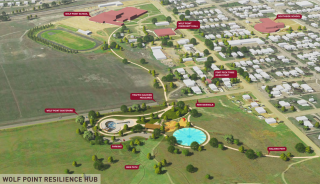
- Fort Peck Assiniboine and Sioux Tribes, Montana: The Fort Peck Assiniboine and Sioux Tribes Reservation in in the far northeast corner of Montana, on the north side of the Missouri River. This technical assistance complemented and built upon the Fort Peck Tribes' Hazard Mitigation Plan, using climate change scenarios and local knowledge to plan for projected changes to extreme weather and drought. The assistance also helped the Tribes develop green infrastructure designs, including resilience hubs and redevelopment of a waste transfer site to be a riverfront park. Implementation plans for these designs fit within the updated Hazard Mitigation Plan and offer co-benefits, such as new outdoor recreation options, ecotourism and space to grow culturally significant plants.
- Keweenaw Bay Indian Community, Michigan: Located on the shores of Lake Superior in Baraga County, portions of the Keweenaw Bay Indian Community land are contaminated with waste material from legacy mining and face significant challenges from coastal erosion. EPA partnered with the Keweenaw Bay Indian Community's Natural Resources Department to better understand the impacts of shoreline erosion along Lake Superior and develop community-informed conceptual design options for green infrastructure projects that can protect cultural, recreational, and infrastructure assets.
-
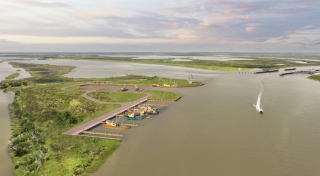
EPA worked with Terrebonne Parish and partners on the conceptual designs of three harbors of refuge and resilience hubs. - State of South Carolina: EPA supported the South Carolina Office of Resilience (SCOR) and partners at South Carolina Department of Health and Environmental Control to meaningfully engage low-income, flood-prone communities in the development of green infrastructure designs on voluntary buyout properties.
Typhoon Recovery in the Commonwealth of the Northern Mariana Islands (2015, 2018)
EPA and FEMA Region 9 collaborated to support the Commonwealth of the Northern Mariana Islands (CNMI) recover from Typhoons Souldeor in 2015 and Yutu in 2018. Through planning calls and on-site workshops throughout 2018, EPA and FEMA assistance led to the development of a guide of adaptation measures, recommendations for government action, planning resources, regulatory instruments, and tools to work toward smart, safe growth in the CNMI.
To follow up on this work, FEMA funded an interagency agreement for further EPA technical assistance and to hire a full-time staff person to help CNMI implement smart growth principles and practices as part of long-term recovery.
- Read the Guide: Guidance Manual for Smart, Safe Growth
Safe Growth Strategies for the San Francisco Bay Area (2014-2015)
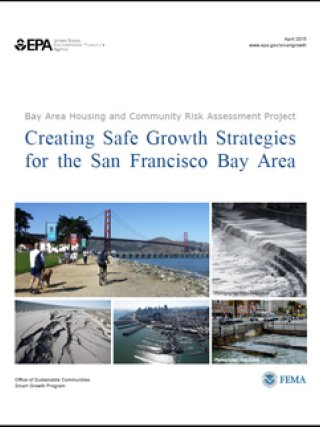
EPA and FEMA partnered with the Association of Bay Area Governments to incorporate resilience to natural hazards and climate change into regional and local land use planning. While focused on the San Francisco Bay area, this project and the final report provide a model other regions and communities could use to assess the vulnerability of their housing and residents and develop strategies to make development safer. The project was funded by FEMA Region 9.
The Association of Bay Area Governments is working to implement a Resilience Program to support safe growth strategies in each of the nine counties in the region.
- Read the Report: Creating Safe Growth Strategies for the San Francisco Bay Area: Bay Area Housing and Community Risk Assessment Project
Flood Resilience and Recovery Assistance for the State of Vermont (2013)
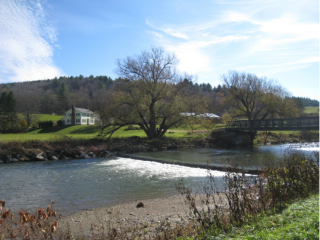
In 2013, EPA and FEMA worked with several Vermont state agencies, including the Vermont Agency of Commerce and Community Development and communities in Vermont’s Mad River Valley, to identify smart growth strategies that can help vulnerable communities prepare for and recover from floods. This planning assistance was delivered through EPA's Smart Growth Implementation Assistance Program.
Although the project focused on policies and hazard mitigation plans for communities in Vermont, the report and its Flood Resilience Checklist can help any community seeking to become more resilient to future floods.
- Read the Report: Planning for Flood Recovery and Long-Term Resilience in Vermont: Smart Growth Approaches for Disaster-Resilient Communities
- Download the Flood Resilience Checklist
Complete Streets Assistance for Joplin, Missouri (2012-2013)
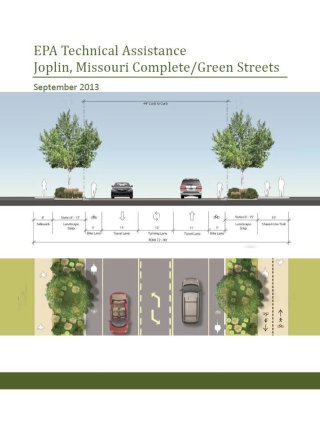
An F-5 tornado hit the East 20th Street corridor in Joplin, Missouri, on May 22, 2011. After the tornado, residents and leaders decided to redesign the corridor as a model for green, complete streets that other locations in the community could follow.
In 2012, EPA provided technical assistance to Joplin to help create green, complete streets, which are attractive; safer for all users, including pedestrians, bicyclists, transit riders and drivers; and incorporate natural elements to manage stormwater. Before the project began, FEMA worked with local stakeholders to identify long-term community recovery needs and helped EPA match its assistance with those needs.
The community built on these efforts, and in 2022, the city of Joplin adopted a Complete Streets Policy, after an 18 month process of community engagement and outreach.
- Read the Report: EPA Technical Assistance: Joplin, Missouri Green/Complete Streets
Preparing for Sea Level Rise in Coastal North Carolina (2012)
In partnership with FEMA, the National Oceanic and Atmospheric Administration (NOAA), and the North Carolina Department of Environmental Management, EPA worked with the coastal towns of Wilmington and New Bern, North Carolina in 2012. Both jurisdictions requested assistance to identify vulnerabilities and assess strategies to reduce the threat of extreme weather events, more frequent flooding, and sea level rise to neighborhoods and water and sewer infrastructure.
The Wilmington project examined ways to protect regional water and sewer infrastructure after a vulnerability assessment revealed that future sea level rise would likely inundate wastewater treatment facilities, pump stations, manholes and other facilities. The EPA and FEMA assistance identified land use and infrastructure strategies that could reduce vulnerabilities, including design solutions such as using green infrastructure, engineering approaches and land use options.
The New Bern project looked at options for using green infrastructure to manage stormwater, reduce flooding risk, and improve water quality in the Gateway District, a historic African-American neighborhood next to downtown. With EPA and FEMA’s assistance, the city explored how green infrastructure could help improve stormwater conveyance and reduce ponding on streets and in yards. The city also identified potential locations in the Gateway District for new green infrastructure.
Land Use Planning Assistance for Spirit Lake Nation (2011)
Spirit Lake Nation is a tribe in North Dakota that has experienced 17 years of chronic flooding. In 2011, FEMA, EPA and outside experts worked with the tribe to develop a land use plan that directs growth away from known flood risk areas and improves overall quality of life on the reservation.
Post-Disaster Assistance to Iowa Communities (2009)
In 2009, FEMA and EPA worked with Iowa state agencies and local partners to help six Iowa communities plan their recovery after floods and tornadoes.
- Information about this work is available in the EPA Archive. Click on Search EPA Archive and search for "Iowa smart growth."
Resources and Strategies for Disaster Recovery and Resilience
Creating Disaster-Resilient Buildings to Minimize Debris
EPA published this resource in July 2024 to provide practical actions for communities to withstand natural disasters and minimize disaster debris.
Land Use and Green Infrastructure Scorecard
This scorecard guides municipalities through a review of local plans, policies and practices to help municipalities protect water resources while maximizing additional community benefits available through green infrastructure, including flood mitigation, public health, and climate resilience.
- Use the Scorecard: Land Use and Green Infrastructure Scorecard
Disaster Resilient Design Concepts
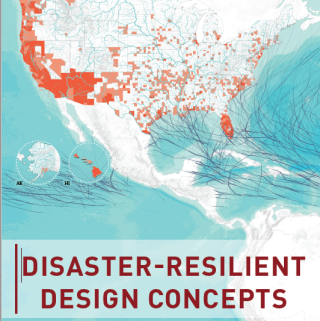
This resource showcases disaster resilient designs that can help communities reduce the impact of disasters, recover more quickly, strengthen local economies and create safer, more equitable places to live by reducing hazards especially for those most vulnerable.
This engaging, easily accessible resource complements more detailed policy guides and planning resources in the links included. The design solutions are offered to inspire a range of stakeholders to come together and invest in projects and infrastructure, to achieve multiple benefits.
- Read the Report: Disaster Resilient Design Concepts
Regional Resilience Toolkit: 5 Steps to Build Large-Scale Resilience to Natural Disasters
This toolkit, created through a partnership among FEMA, EPA and the Metropolitan Transportation Commission/Association of Bay Area Governments (MTC/ABAG), helps regions plan for disasters by working across multiple jurisdictions and with nongovernmental partners.
- Access the Toolkit: Regional Resilient Toolkit: 5 Steps to Build Large-Scale Resilience to Natural Disasters
Building Resilient States: A Framework for Agencies
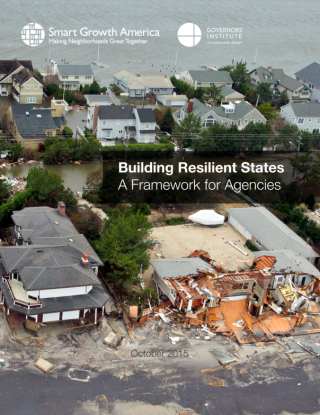
In 2014, EPA convened 126 representatives from 26 states, as well as FEMA, HUD, and NOAA, as part of the Governors' Institute on Community Design, to discuss policies and practices for creating resilient communities. A framework and policy options were developed as an outcome of the State Resilience and Economic Growth Summit, to support states build their resilience to natural disaster.
- Read the Report: Building Resilient States: A Framework for Agencies
